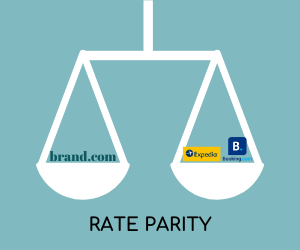Here are five revenue management terms and acronyms that every hotel revenue analyst should know, including Rate Parity, RevPAR, GOPPAR, EBITDA and Total Revenue Management.

1. What is Rate Parity?
Rate Parity is the practice of offering the same rate and terms for a specific room type through every distribution channel for a hotel.
Rate Parity clauses are part of an agreement between a hotel and an OTA (Online Travel Agency) which restricts the hotel from advertising cheaper prices on their own websites.
There are two types of Rate Parity; Wide Rate Parity and Narrow Rate Parity.
What is Wide Rate Parity?
Wide Rate Parity is the agreement between a hotel and the OTA’s where the hotel agrees not to undercut the room prices across all distribution channels including the hotel’s own website and on other OTAs.
What is Narrow Rate Parity?
Narrow Rate Parity clauses allow hotels to offer lower rates through other OTA’s or through indirect or offline channels such as loyalty programs, via email and phone. However, under this clause hotels can still not not advertise a lower rate on their own website.
Rate Parity has been the subject of much debate. In 2013 Germany was the first country to introduce regulations covering hotel rate parity. Since then several other European countries have restricted or prohibited either one or both of the OTA rate parity clauses.
Earlier this year Booking.com and Expedia announced they would only implement Narrow Rate Parity clauses in Australia, New Zealand and the EU. While in other major markets they continue to adopt Wide Rate Parity clauses.
2. What is RevPAR?
RevPAR is the acronym for Revenue Per Available Room
RevPAR is one of the key financial metrics in hotel revenue management to see how the hotel performs in terms of revenue generated by the rooms. It does not take into account any other revenue generating activities and income streams of the hotel.
How do you calculate RevPAR?
Rooms Revenue / All Available Rooms = RevPAR
3. What is GOPPAR?
GOPPAR is the acronym for Gross Operating Profit Per Available Room
GOPPAR takes into account the number of rooms available to sell in a hotel, rather than the number of rooms sold. And because GOPPAR looks at the Gross Operating Profit, rather than just the revenue from selling hotel rooms it is a good indicator as to how the hotel is doing overall. GOPPAR is a particularly useful measure for investors and hotel owners because it gives them a total picture of the value of their hotel asset.
How do you calculate GOPPAR?
Gross Operating Profit^ / Available Rooms = GOPPAR
^Gross Operating Profit = Gross Revenue – Gross expenditure
4. What is EBITDA?
EBITDA is the acronym for Earnings Before Interest, Taxes, Depreciation and Amortization.
The EBITDA as a measure is used to determine, analyse and compare the profitability of a hotel.
How do you calculate EBITDA?
Revenue – Expenses^ = Ebitda
^Expenses = the hotel’s total earnings before interest, tax, amortization and depreciation
5. What is Total Revenue Management?
Total Revenue Management is the active management of all revenue sources in a hotel. This includes rooms, F&B, Spa, Gym, WiFi, Conferencing, Tours/Activities and every other income stream the hotel generates.
A Total Revenue Management strategy implies that management of the revenue is applied to every hotel department, with the objective to optimise profits for each department by maximising the revenue and controlling costs. It is said that Total Revenue Management is the future of Hotel Revenue Management
ABOUT NUVHO
Nuvho is a Hotel Services & Management Company focused on revenue generation for hoteliers. We offer outsourcing, training and support in the areas of Sales, Marketing, Revenue, Yield & Distribution Management.
We also offer one of the best and most cost-effective booking engines on the market. It features an in-built OTA price comparison tool and has a proven high conversion rate, achieving between 5% to 7% for our hotel clients. The system integrates with most PMS and channel management systems.


